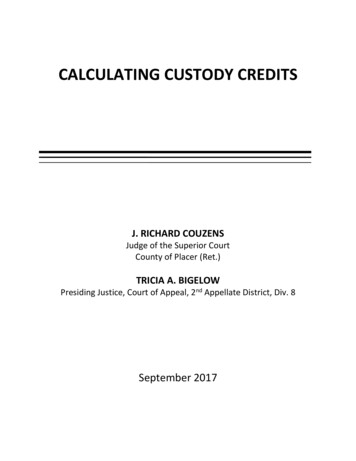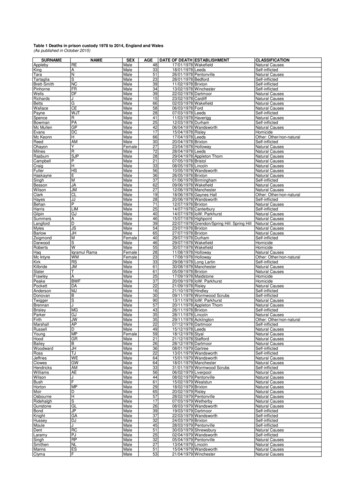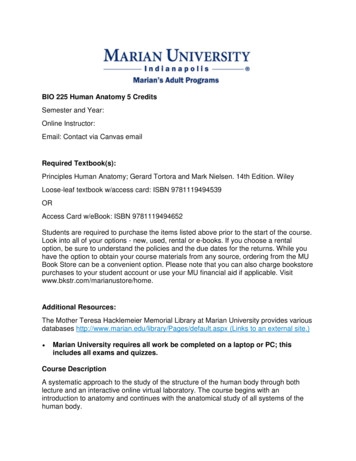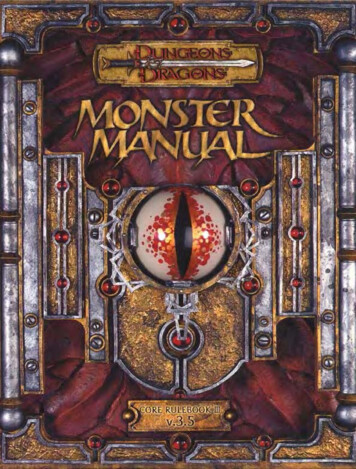
Transcription
CALCULATING CUSTODY CREDITSJ. RICHARD COUZENSJudge of the Superior CourtCounty of Placer (Ret.)TRICIA A. BIGELOWPresiding Justice, Court of Appeal, 2nd Appellate District, Div. 8September 2017Rev.9/171
NEW TO THIS EDITIONThis September 2017 edition contains non-substantive corrections for theMay edition, and the following new or revised material:Page 28 – People v. Alford, People v. Moore, People v. Martinez, and Peoplev. Webb re penalty assessments for drug program assessment andcrime lab assessmentPage 29 – People v. Talibdeen re mandatory nature of penalty assessmentsPages 35 – 38 – Credit against infraction finesRev.9/172
NEWTABLE OF CONTENTSA. INTRODUCTION . 5B. THE APPLICABLE RULES. 61. People v. Brown . 72. Summary of applicable rules . 83. Crimes committed prior to September 28, 2010 or violations of probation basedon crimes committed prior to September 28, 2010 . 8a. Credits for crimes committed prior to September 28, 2010, but custody isserved after that date . 10b. Credits for violations of probation based on crimes committed prior toSeptember 28, 2010. 124. Crimes and violations of probation with underlying crimes committed betweenSeptember 28, 2010, and October 1, 2011 . 12a. Violations of probation based on underlying crimes committed betweenSeptember 28, 2010, and October 1, 2011 . 135. Crimes and violations of probation with underlying crime committed on or afterOctober 1, 2011 . 13a. Sentences to county jail . 14b. Sentences to state prison . 14c. Credit for sentences imposed after October 1, 2011, for crimes committedprior to the effective date. 15d. Violations of probation . 156. Credit for time served while on postrelease community supervision (PRCS) orparole . 157. Credits and parole eligibility as a result of a federal court order . 16C. EXCLUSION FROM THE ENHANCED CREDIT PROVISIONS . 181.2.3.4.Defendants who are required to register as a sex offender under section 290 . 18Defendants committed for a serious felony listed in section 1192.7. 18Defendants who have prior convictions for a serious or violent felony . 19Defendants who are subject to special credit limitations . 19D. CALCULATION OF CREDITS . 191. FORMULA A [Traditional formula] . 20Rev.9/173
2. FORMULA B [Formula effective January 25, 2010, and October 1, 2011] . 213. FORMULA C [Credit formula effective September 28, 2010 – state prison] . 22E. ADDITIONAL ISSUES . 221.2.3.4.5.6.7.Whether disqualifying conditions must be pled and proved . 22Effect of striking of prior serious or violent felonies under section 1385 . 22Correction of award of credits . 23Equal protection. 24Credits and Three Strikes cases . 25Challenges to credits . 25Applying custody credits to fines . 25a. Background . 26b. Calculation of custody credits applied to fees and fines . 27c. Base fine . 27d. Base fine fully satisfied . 29e. Base fine partially satisfied . 29f. Rounding down . 32g. Community service . 32h. Restitution fines and community service . 34i. Credit against infraction fines . 34j. State prison custody credit . 38k. Effective date of change . 38APPENDIX I: AWARDING CONDUCT CREDITS UNDER P.C. §§ 4019 AND 2933. 39Copyright 2017 Barrister PressPermission is granted to copy and distribute these materials to the judges and staffof the California judiciaryRev.9/174
A.IntroductionThe rule is straightforward: “The sentencing court is responsible for calculating thenumber of days the defendant has been in custody before sentencing and for reflectingthe total credits allowed on the abstract of judgment.” (People v. Black (2009) 176Cal.App.4th 145, 154; also People v. Buckhalter (2001) 26 Cal.4th 20, 30-31.) It is theobligation of the court to determine at the time of sentencing the actual time and conductcredits to be awarded against the sentence. (Cal. Rules of Court, Rule 4.310.) Thestatement of credits should include the total credits given, broken down between actualtime and any good time/work time conduct credits. The court’s task, however, is anythingbut straightforward. It has been complicated by the fact that there have been a numberof changes to the statutes governing the award of conduct credits. The purpose of thismemorandum is to offer some guidance to trial judges and counsel as they navigate theirway through the maze of changing rules and credit formulas.Penal Code section 4019, 1 governing the award of county jail conduct credits, has hadfour distinct versions of the credit formula:Prior to January 25, 2010, section 4019 gave defendants confined in or committed tocounty jail six days or more two days of conduct credit for every six days of actual custodytime served, or one-third off their sentence. Stated differently, for every four days ofactual time served, a total of six days of the sentence would be deemed served. This creditwas awarded to defendants committed to county jail for a misdemeanor or as a conditionof probation in a felony case, and as a matter of pre-sentence credit to defendantssentenced to state prison.Effective January 25, 2010, section 4019 was amended to give defendants confined in orcommitted to county jail four days or more two days of conduct credit for every four daysof actual custody time served, or approximately one-half off their sentence. In otherwords, for every two days of actual time, four days of the sentence was deemed served.The net effect of the change was to give an extra two days of credit for every two daysactually served. The credit applied to persons sentenced to county jail, and to presentence credits for persons sent to state prison. Excluded from the enhanced creditprovisions were defendants who had a prior conviction for a serious or violent felony,defendants who were being sentenced on a serious felony, and any person required toregister as a sex offender under section 290.1Unless otherwise indicated, all statutory references are to the Penal CodeRev.9/175
Effective September 28, 2010, section 4019 returned to its wording prior to January 25,2010: persons confined in or committed to county jail six days or longer would receivetwo days of conduct credit for every six days of actual custody time served. The newprovisions eliminated the enhanced credits for persons sentenced to county jail. Section2933, a statute applying to credits in state prison, was amended to grant personssentenced to prison one day of credit for every day of pre-sentence time served in countyjail. Excluded from the enhanced credit provisions were defendants who had a priorconviction for a serious or violent felony, defendants who were being sentenced on aserious felony, and any person required to register as a sex offender under section 290.The excluded defendants would receive only two days of conduct credit for every six daysserved. The statutory change applied only to crimes committed on or after September 28,2010.Effective October 1, 2011, as a result of the enactment of the Criminal JusticeRealignment Act of 2011, section 4019 was amended to provide that inmates confined inor committed to county jail four days or longer are to receive two days of conduct creditfor every four days served, or approximately one-half off their sentence. In other words,for every two days of actual time in custody, four days of the sentence will be deemedserved. As with the change made on January 25, 2010, the net effect of the amendmentis to give an extra two days of credit for every two days actually served. The provisionsapply to persons serving a misdemeanor sentence, a term in jail imposed as a conditionof probation in a felony case, pre-sentence credit for persons sentenced under section1170(h), some persons sentenced to state prison, and persons serving jail custody forviolation of state parole or Post-Release Community Supervision (PRCS). The newprovisions also apply to persons denied felony probation and sentenced to county jailunder section 1170(h). The Legislature eliminated the provisions in section 4019 whichexcluded the enhanced credit award for persons convicted of prior serious or violentfelonies, persons committed for serious felonies, and persons required to register undersection 290. Section 2933, governing credit for persons sent to state prison, was restoredto its original language: state prison inmates will receive six months of conduct credit forevery six months of actual time served. There are no exclusions from this formula, onlyconduct credit limitations such as sections 2933.1 [violent felonies] and 2933.2 [murder].The amendments made by the realignment legislation are to be applied prospectivelyonly to crimes committed on or after October 1, 2011.B.The Applicable RulesThe question of what rule will apply to any given sentence will depend on the potentialrelationship between four variables: 1) when the crime is committed; 2) when thecustody time is served; 3) whether the defendant is disqualified from receiving enhancedcredits under the applicable statute; and 4) whether the defendant receives a state prisonor county jail sentence. One or a combination of these variables will dictate the applicablelaw and the correct formula to use in the calculation of credits. There are three primaryRev.9/176
time periods and sentencing circumstances relevant to this determination. The analysis,however, must start with an understanding of the Supreme Court's decision in People v.Brown.1.People v. BrownMost of the published opinions addressing the changes to section 4019 concerndefendants who committed a crime and were sentenced before the effective dateof the amendment to section 4019, but the case was not final as of that date. Thecourts were widely split on the question of which law applied to the calculation ofcredits. The conflict was resolved by the Supreme Court in People v. Brown (2012)54 Cal.4th 314.Brown requires the custody credit change made January 25, 2010, to be appliedprospectively. “We hold that former section 4019 [operative January 25, 2010]applied prospectively, meaning that qualified prisoners in local custody firstbecome eligible to earn credit for good behavior at the increased rate beginningon the statute’s operative date.” (Brown, supra, 54 Cal.4th at p. 318.) The opinionis based on the strong presumption created by section 3: “No part of the [PenalCode] is retroactive, unless expressly so declared.” The court determined therewas no such declaration regarding the changes made to section 4019, nor couldsuch an intent be inferred from extrinsic sources.As a result, defendants are to receive custody credit based on the law effectivewhen the time is served. “To apply former section 4019 prospectively necessarilymeans that prisoners whose custody overlapped the statute’s operative date (Jan.25, 2012) earned credit at two different rates.” (Brown, supra, 54 Cal.4th at p.322.) Even though a court sentences a defendant after the effective date, theconduct credits earned prior to the effective date must be determined under theprior law to avoid any impermissible retroactive application of the new statute.“Credits are determined and added to the abstract of judgment at the time ofsentencing, but they are earned day by day over the course of a defendant’sconfinement as a predefined, expected reward for specified good behavior.” (Id.at p. 322; emphasis original.)The court declined to apply In re Estrada (1965) 63 Cal.2d 740. Estrada held thatwhen the Legislature reduces the punishment for a specific crime, the benefit ofthat reduction extends to all defendants whose cases are not final as of the dateof the change. Brown observed that the change to section 4019 did not reducethe penalty for a particular crime; rather the change relates to an increase incustody credit for a defendant’s conduct in the future. “Estrada is today properlyunderstood, not as weakening or modifying the default rule of prospectiveoperation codified in section 3, but rather as informing the rule’s application in aRev.9/177
specific context by articulating the reasonable presumption that a legislative actmitigating the punishment for a particular criminal offense is intended to apply toall nonfinal judgments.” (Brown, supra, 54 Cal.4th at p. 324.)Finally, Brown rejected any equal protection considerations. The court noted thatconduct credits are intended to reward good behavior which happens after theentitlement to the credit, not conduct occurring prior to the existence of thecredit. The court distinguished In re Kapperman (1974) 11 Cal.3d 542, on the basisthat Kapperman concerned the equal protection right to actual time credit whichis given irrespective of behavior by the defendant; here the issue was conductcredit which must be earned. "Credit for time served is given without regard tobehavior, and thus does not entail the paradoxical consequences of applyingretroactively a statute intended to create incentives for good behavior.Kapperman does not hold or suggest that prisoners serving time before and afterthe effective date of a statute authorizing conduct credits are similarly situated."(Brown, supra, 54 Cal.4th at p. 330; emphasis original.)2.Summary of applicable rulesBased on Brown and other cases that discuss the awarding of conduct credits, thedetermination of the correct formula for the calculation of conduct credits comesdown to the application of two basic principles: For crimes committed prior to September 28, 2010, look to the formulaapplicable when the time was served. For crimes committed on or after September 28, 2010, look to theformula applicable when the crime was committed.See Section D, infra, for a discussion of the specific custody credit formulas.3.Crimes committed prior to September 28, 2010 or violations of probation basedon crimes committed prior to September 28, 2010For time served prior to January 25, 2010, defendants confined in or committedto county jail six days or more will receive two days of conduct credit for everysix days of actual custody time served, or one-third off their sentence. Stateddifferently, for every four days of actual time served, a total of six days of thesentence would be deemed served. This credit is awarded to defendantscommitted to county jail for a misdemeanor or as a condition of probation in afelony case, and as a matter of pre-sentence credit to defendants sentenced tostate prison.For time served after January 25, 2010, defendants confined in or committed tocounty jail four days or more will receive two days of conduct credit for everyRev.9/178
four days of actual custody time served, or approximately one-half off theirsentence. In other words, for every two days of actual time, four days of thesentence was deemed served. The credit applies to persons sentenced to countyjail, and to pre-sentence credits for persons sent to state prison. Excluded fromthe enhanced credit provisions are defendants who have a prior conviction for aserious or violent felony, defendants who are being sentenced on a seriousfelony, and any person required to register as a sex offender under section 290.For crimes committed at any time prior to September 28, 2010, or for probationviolations where the underlying crime was committed prior to that date, theselection of the correct custody credit formula will depend on when the time wasserved. The formula changes on January 25, 2010, the effective date of the firstamendment to section 4019. If the time was served prior to January 25, 2010, thetraditional formula under section 4019 will apply. If the time was served afterJanuary 25, 2010, the new credit formula will apply. If the time was served duringboth time periods, credits will be calculated separately under each formula.Because the court is selecting a credit formula based on when the time wasserved, the specific selection is not based on when the crime was committed,when the case was sentenced, whether the case was final as of January 25, 2010,or whether the defendant is serving time for a probation violation based on anunderlying crime committed before or after January 25, 2010.The time period prior to September 28, 2010, was discussed in Brown: “To applyformer section 4019 prospectively necessarily means that prisoners whosecustody overlapped the statute’s operative date (Jan. 25, 2010) earned credit attwo different rates. Defendant contends such a result is impermissible because acourt may apply only the version of section 4019 in effect at the time sentence isimposed (or modified on appeal). Defendant bases this argument on section2900.5, which requires the sentencing court to determine and include in theabstract of judgment the presentence credits to which a defendant is entitled (id.,subd. (d)), including days ‘credited to the period of confinement pursuant toSection 4019’ (§ 2900.5, subd. (a), italics added). Defendant thus reads theitalicized reference to section 4019 as meaning ‘the version of section 4019currently in effect.’ Defendant’s reading would violate section 3 by causing anylegislative change in the credit-accrual rate to operate retroactively without anexpress de
re penalty assessments for drug program assessment and crime lab assessment . Page 29 – People v. Talibdeen re mandatory nature of penalty assessments . Pages 35 – 38 – Credit agai











